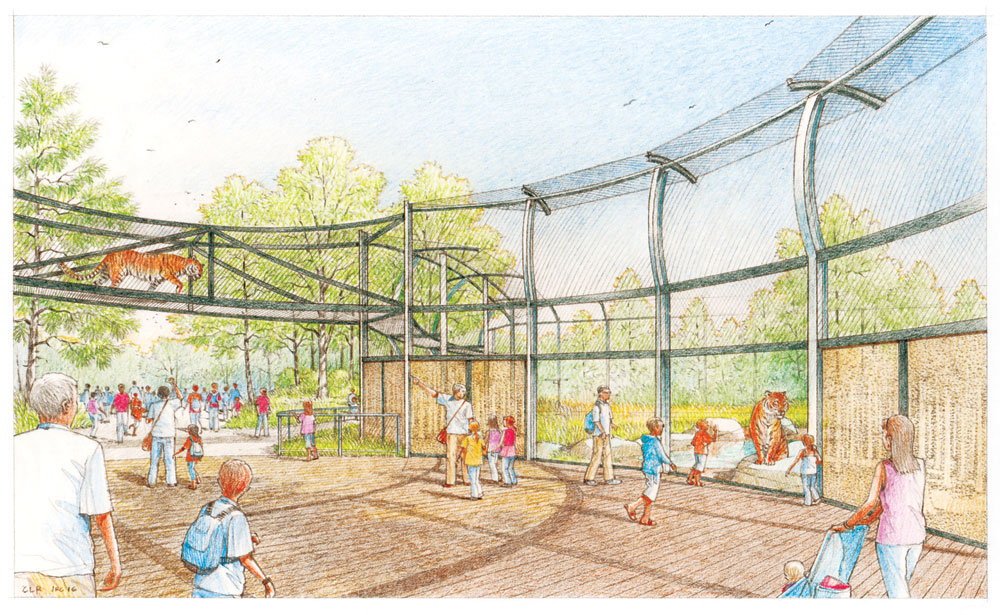
Nikolai, one of the Denver Zoo’s two Amur Tigers, enjoys a snowy February day. Because the animals love snow, the new tiger exhibit will be open year round.

A rendering of The Edge, the new tiger exhibit to open in summer 2016, shows the upper deck where tigers will be able to roam and watch visitors below.
Denver Zoo announced on February 3 it will open a new Amur tiger exhibit, “The Edge,” this June. This is the first major project in the zoo’s New Master Plan to revamp existing buildings and construct new exhibits.
Amur tigers, also called Siberian tigers, are one of the most popular animals at Denver Zoo, according to Shannon Block, president and CEO of Denver Zoo. Currently, the zoo has two Amur tigers, brothers Thimbu and Nikolai. Thimbu is taller and longer than his brother, with light colors. Nikolai is a little more carefree and playful.
“Are they beautiful or what?” Mayor Michael B. Hancock said at the press conference to reveal the new exhibit. At that moment, Nikolai stood up on his back paws right on the other side of the glass to peek above, silhouetting Mayor Hancock in the tiger. iPhone camera flashes set off like fireworks. “First of all, I recognize that none of you are listening to one thing I say because you’re watching this tiger,” Hancock said and the crowd laughed.
The current Amur tiger exhibit, which was built in 1964, has a small outdoor space. Tigers naturally like to perch and watch people, but the exhibit has no vertical space for them to climb. Thimbu and Nikolai sit on a tiny part of a chain link fence that is wrapped around a tree about three feet above the ground. The fence is meant to protect the tree, but has become their favorite spot in an attempt to get a higher view.
The current exhibit also limits visitor experience—they have one option to view the tigers through a glass panel.
“If we sat down today to design a tiger exhibit, this is not what we would decide because the industry, the research and the care of these animals has progressed to a point where they want more space, light and verticality,” says George Pond, vice president for design and campus management.
Because of $2.2 million from the Better Denver Bond Program, Denver Zoo will build an entirely new exhibit that gives the tigers a lot more choices, including climbing space, pools, and added outdoor area. It is designed to show off the natural athleticism and mysticism of the animals, according to Pond.
The tigers’ outdoor space will grow by 50 percent at The Edge. The exhibit uses a trail system design where tigers can move from one area to another through connecting corridors. The bridges will be four-feet wide and 12 feet above visitors so tigers can roam and perch. “It’s really an opportunity to put our guests and tigers in a unique situation.”
This concept of overhead plastic decking has been used in zoos around the U.S., but this is the first time for Denver Zoo.
The Edge will have pools for the tigers to swim in. A dozen 120-year-old pine trees will be planted to simulate their natural environment. And a 3,000-square-foot facility will be built at the back of the exhibit for zookeepers and veterinarians to provide care, administer procedures or shots, and drop in food.
Pond believes the new exhibit will be better for both visitors and animals. “If you design smartly, exhibits should enhance visitor and animal experience, always keeping animal care first in mind,” Pond says.
After the exhibit opens, the zoo will add another Amur tiger, Nikita, who was born at the Pittsburgh Zoo and currently lives at Omaha’s Henry Doorly Zoo and Aquarium. Her favorite activities include ripping up phone books and scratching logs, according to Shannon Block.
Denver Zoo announced it will also feature the traveling exhibit “Washed Ashore, Art to Save the Sea” from Sept. 24, 2016, to Jan. 16, 2017. The exhibit includes 15 sea-life sculptures made from trash washed up on beaches. It’s meant to raise awareness of marine debris and plastic pollution. For more information, visit DenverZoo.org.




0 Comments